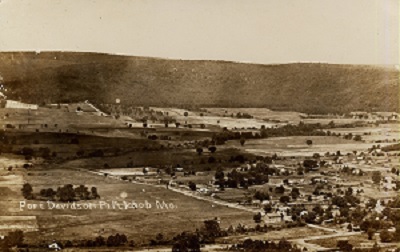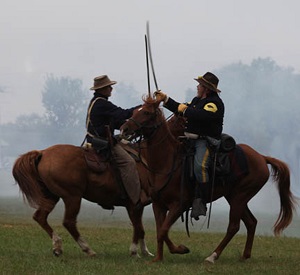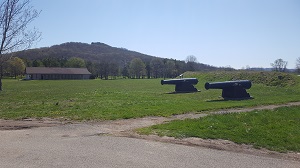at Battle of Pilot Knob State Historic Site
The Battle of Pilot Knob
 The town of Pilot Knob occupied a strategic position, north of the gap between Pilot Knob Mountain and Shepherd Mountain and at the terminus of the St. Louis and Iron Mountain Railroad in the iron-rich Arcadia Valley. During the summer of 1863, Federal troops and a company of Black freemen built a fort on an open plain in the valley floor southwest of the town. While the fort was well positioned to withstand infantry assaults, it was vulnerable to artillery attacks from the surrounding Shepherd Mountain and Pilot Knob.
The town of Pilot Knob occupied a strategic position, north of the gap between Pilot Knob Mountain and Shepherd Mountain and at the terminus of the St. Louis and Iron Mountain Railroad in the iron-rich Arcadia Valley. During the summer of 1863, Federal troops and a company of Black freemen built a fort on an open plain in the valley floor southwest of the town. While the fort was well positioned to withstand infantry assaults, it was vulnerable to artillery attacks from the surrounding Shepherd Mountain and Pilot Knob.
Fort Davidson was a hexagonal earthwork with approximately 150-foot-long sides. The walls were constructed of packed earth lined with planks on the interior and a dry moat that encircled the fort. It was equipped with four huge cannons and several smaller ones with large ammunition storage in the center. The fort was named after Brig. Gen. John W. Davidson, commander of the Southeast Missouri District, and was manned by local Union militia and volunteer infantry.
In September 1864, Confederate Maj. Gen. Sterling Price led the largest Confederate cavalry raid of the war into Missouri. Objectives of Price’s Raid were to divert Union troops east of the Mississippi River, gather Confederate recruits, capture and destroy Union war materials and, if possible, capture St. Louis or Jefferson City.
 En route to the St. Louis area, Price decided to attack the weakly defended Fort Davidson at Pilot Knob. When word of the possible attack reached Union forces, Gen. Thomas Ewing and two companies of an Iowa unit were sent to Pilot Knob to help defend the fort, bringing the Union forces to approximately 1,500 troops.
En route to the St. Louis area, Price decided to attack the weakly defended Fort Davidson at Pilot Knob. When word of the possible attack reached Union forces, Gen. Thomas Ewing and two companies of an Iowa unit were sent to Pilot Knob to help defend the fort, bringing the Union forces to approximately 1,500 troops.
Price’s leading regiments engaged Union pickets at 1 p.m. on Sept. 26, 1864, entering the town of Ironton. As the rebel strength grew, the small Union force was pushed back toward the fort. During the night, the Confederate army camped south of the fort and prepared to strike the next day.
On Sept. 27, an 8,000-man Confederate force attacked the fort in a series of infantry assaults. Confederate cannons on Shepherd Mountain fired on the fort just before four brigades of Southern troops charged. Union troops still defending Pilot Knob Mountain were engulfed while those on Shepherd Mountain safely retreated to the fort with the Confederate wave cresting behind them.
The poor timing of the assaults allowed heavy fire from the garrison to be directed at each attacking brigade. Only one Confederate brigade reached the fort. It advanced across the open plain under murderous fire, halting only when it reached the fort’s moat, where the Union soldiers threw hand grenades down on them. The assault was broken. Despite suffering staggering casualties, Price’s men failed to take the walls of Fort Davidson. The 20-minute battle resulted in 1,000 Confederate troops killed or wounded, while the Union force suffered less than 100 injured or killed. The Confederate forces fell back to reorganize and prepare for a renewed attack the next day.
 Ewing, low on ammunition for his cannons, knew his Union forces could not hold out a second day and he ordered the evacuation of Fort Davidson. Under cover of darkness in the early morning hours, soldiers silently exited the fort, taking a couple of cannons with them. They marched past Price’s men, who mistook them for their own men. A small group of soldiers were left behind long enough to blow up the powder magazine, destroying the fort’s remaining supplies. When Gen. Price investigated the explosion, he found the fort in ruins and the men gone.
Ewing, low on ammunition for his cannons, knew his Union forces could not hold out a second day and he ordered the evacuation of Fort Davidson. Under cover of darkness in the early morning hours, soldiers silently exited the fort, taking a couple of cannons with them. They marched past Price’s men, who mistook them for their own men. A small group of soldiers were left behind long enough to blow up the powder magazine, destroying the fort’s remaining supplies. When Gen. Price investigated the explosion, he found the fort in ruins and the men gone.
Once past the enemy, the Union soldiers marched out of the valley to the hamlet of Leasburg, successfully fighting off the troops Price sent to find them. From Leasburg, Ewing headed to Rolla, freeing that city’s garrison to reinforce Jefferson City.
The Confederates paid a heavy price for the Battle of Pilot Knob. In addition to losing 1,000 troops, Price’s decision to attack Fort Davidson slowed his advance, giving the Union army more time to prepare to defend St. Louis and Jefferson City. Price abandoned the idea to attack St. Louis and set his sights on Jefferson City but found Federal forces waiting. Reluctant to assault another entrenched position, Price decided to bypass the town and continue westward.






